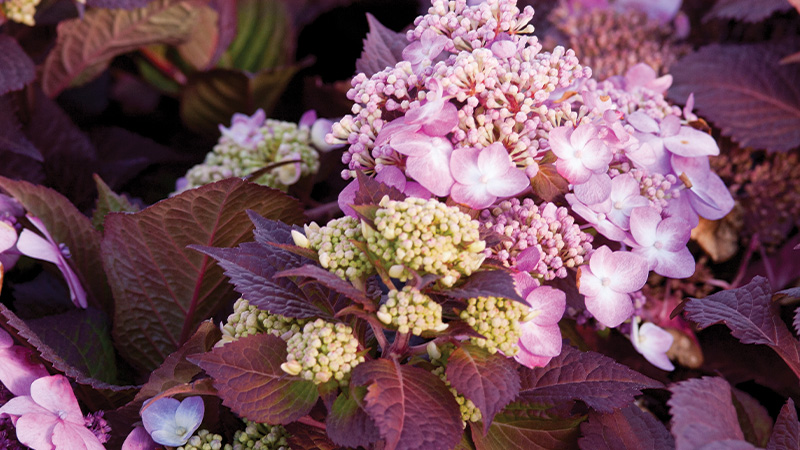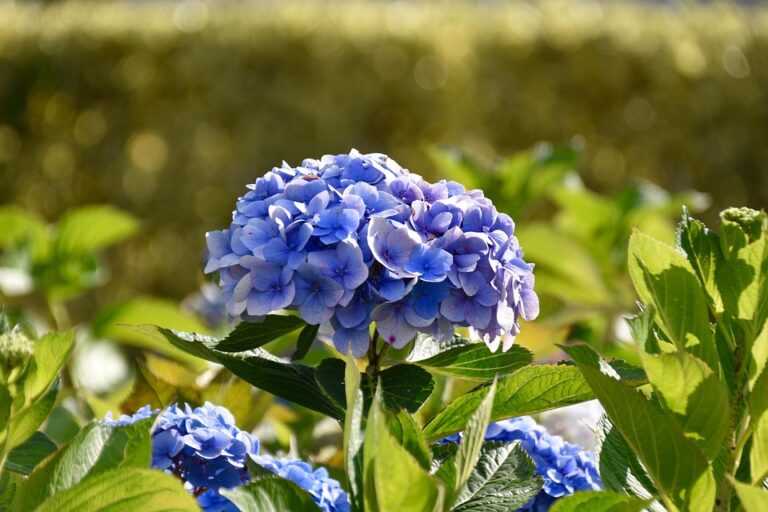Fall Hydrangea Care: Watering, Mulch, What Not to Do
A practical, type-specific guide to prepare your hydrangeas for winter and maximize next year’s blooms—exact watering, mulch depths by climate, pruning rules by type, and what not to do.
- Water in-ground shrubs deeply once before the ground freezes; containers: water lightly every 4–6 weeks during dormancy, just to prevent wilt. hydrangea.com, The Spruce
- Mulch 2–3″ in average climates; 4–6″ in cold zones; up to 8–12″ temporary crown protection in extreme cold; keep mulch off stems. Savvy Gardening, The Spruce, hydrangea.com
- Don’t prune old-wood bloomers (and most rebloomers) in fall; skip fast-acting fertilizers. Compost top-dressing is safe. Proven Winners, Endless Summer Hydrangeas, Savvy Gardening
- Protect old-wood buds in cold/windy sites with burlap or a straw-filled cage; move containers indoors around 45°F. The Spruce

Identify your hydrangea’s bloom wood before any cuts. Bigleaf/mountain/oakleaf bloom on old wood and resent fall pruning; panicle/smooth bloom on new wood and are more flexible (safer to prune late winter/early spring). Proven Winners, The Spruce, Gardening Know How
How Hydrangeas Set Buds: Old Wood vs New Wood
Bigleaf (H. macrophylla) and oakleaf (H. quercifolia) form next year’s flowers on this season’s stems (old wood), so buds overwinter on the plant. Prune in fall and you risk removing the show. Panicle (H. paniculata) and smooth (H. arborescens) bloom on new wood, which allows reshaping closer to dormancy, though late-winter cuts reduce winter injury risk. Many modern bigleaf/mountain rebloomers flower on both old and new wood—treat these conservatively like old-wood types. Proven Winners, The Spruce, Gardening Know How
| Type (Botanical) | Blooms On | Fall Pruning? | Notes |
|---|---|---|---|
| Bigleaf (H. macrophylla) | Old wood (some rebloomers: old + new) | No (except dead/diseased wood in spring) | Protect buds in cold/windy sites |
| Mountain (H. serrata) | Old wood (some rebloomers) | No (except dead/diseased wood in spring) | Handle like bigleaf |
| Oakleaf (H. quercifolia) | Old wood | No | Excellent fall color |
| Smooth (H. arborescens) | New wood | Prefer late winter/early spring cuts | Annabelle, Invincibelle series |
| Panicle (H. paniculata) | New wood | Optional after dormancy; safer late winter | Limelight, Pinky Winky |
Watering In Fall: How Much, How Often, When to Stop

In the two to three weeks before your ground freezes, give in-ground shrubs one deep soak to charge the root zone. In zones 3–7, that single thorough watering is typically sufficient; in zones 7–11, water infrequently but deeply through extended winter dry spells. Underwatering going into winter is more problematic than a slightly moist profile. hydrangea.com
Containers are different: once moved to an unheated, sheltered space around 45°F (garage, shed, basement), keep them on the dry side. Water lightly every 4–6 weeks—just enough to prevent wilting—and never leave pots sitting in saucers of water. They don’t need light during dormancy. The Spruce, Savvy Gardening
Mulching In Fall: Depths by Climate and Materials

- Average climates: 2–3″ of shredded bark, arborist chips, or shredded leaves (keep off stems). Savvy Gardening
- Cold-winter zones: 4–6″ for root insulation; site near structures for extra protection. The Spruce
- Extreme cold or young shrubs: up to 8–12″ temporary crown mound for old-wood types; pull back in early spring. hydrangea.com
To “feed while mulching,” top-dress 1–2 bags of compost per shrub out to just beyond the dripline; it improves soil tilth and enhances moisture retention for spring. Refresh mulch lightly in spring. Hyannis Country Garden
What Not To Do In Fall
- Don’t prune old-wood bloomers (and rebloomers) in fall: you’ll likely remove next year’s buds. Proven Winners, Gardening Know How
- Don’t apply fast-acting fertilizers: they push tender growth that winter will damage. Compost is fine; if using slow-release organics, apply very late fall with caution—or defer to spring. Endless Summer Hydrangeas, Savvy Gardening, The Spruce
- Don’t leave containers exposed to repeated freeze–thaw: shift indoors around 45°F. The Spruce
Pruning By Type: If, When, and How
Bigleaf, Mountain, Oakleaf: Resist fall cuts. If tidying, snip spent blooms with just an inch or two of stem—no more. Save structural work for post-bloom in summer, or remove only dead wood as buds break in spring. Savvy Gardening, The Spruce
Panicle, Smooth: These bloom on new wood; you may prune after dormancy or, preferably, late winter/early spring to minimize winter injury. Limit reductions to ~one-third yearly to maintain structure and vigor. Proven Winners, Gardening Know How

Regional Protection and Winter Prep
Cold winters and wind are hardest on old-wood buds. In zones with extended freezing, use thicker mulch, site near buildings for windbreak, and protect with burlap wraps or a wire cylinder filled with straw. Panicle and smooth types can be cut back and mulched thickly in harsher climates; move containers indoors below ~45°F. The Spruce

Step-by-Step Fall Checklist
🧭 Identify Your Type
Bigleaf/mountain/oakleaf (old wood) vs. panicle/smooth (new wood). When unsure, skip fall pruning. Proven Winners
🧹 Clean Leaf Litter
Remove diseased/pest-affected leaves; dispose rather than compost if infected. Hyannis Country Garden
🌱 Top-Dress Compost
Apply 1–2 bags per shrub out to just beyond the dripline. Hyannis Country Garden
🪵 Mulch by Climate
2–3″ typical; 4–6″ cold zones; up to 8–12″ temporary crown mound for extreme cold. Savvy Gardening, The Spruce, hydrangea.com
💧 Final Deep Watering
One deep soak before freeze for in-ground shrubs; containers: move near 45°F and water lightly every 4–6 weeks. hydrangea.com, The Spruce
🧣 Protect Old-Wood Buds
Use burlap or a straw-filled cage in cold/windy sites; avoid cutting old-wood types now. The Spruce, Proven Winners
- Pruned old-wood in fall: Focus on bud protection (thicker mulch, windbreaks) and limit spring cuts to dead wood; expect fewer blooms this cycle. Proven Winners
- Hard frost blackened leaves: Leave stems; clean leaf litter; protect through winter; reassess in spring as buds break. Savvy Gardening
- Panicle/smooth too large: Prefer late-winter reduction by ~one-third vs. annual hard cuts. Proven Winners

Old-wood and reblooming types: no. New-wood types: acceptable after dormancy, but safest late winter/early spring. Proven Winners, Gardening Know How
2–3″ typical; 4–6″ in cold zones; up to 8–12″ temporary crown protection for extreme cold—always keep off stems. Savvy Gardening, The Spruce, hydrangea.com
Use compost now; skip fast-acting fertilizers. If using slow-release organics at all, apply very late fall cautiously—or wait for spring. Endless Summer Hydrangeas, Savvy Gardening, The Spruce
Next Steps
Identify your type, clean leaf litter, top-dress compost, set mulch depth, schedule your final deep soak, and plan protection for old-wood types in cold/windy locations. Move containers indoors near 45°F and water sparingly through dormancy. Hyannis Country Garden, hydrangea.com, The Spruce
